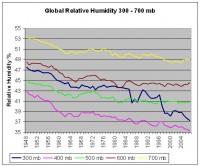By Ken Gregory of Friends of Science
The paper, Greenhouse Effect in Semi-Transparent Planetary Atmospheres by Ferenc M. Miskolczi shows that the current greenhouse effect equations are incomplete because they do not include the correct boundary conditions. The new theory presented in this paper shows that the atmosphere maintains a “saturated” greenhouse effect, controlled by water vapor content. There is no physics, no equations in the models that determines the strength of the greenhouse effect. Parameters are just set to obtain the observed temperature. The greenhouse effect is dominated by water vapour, so how it changes with increasing CO2 is critical. All the General Circulation Models (GCM) or more commonly called Global Climate Models just set: Relative humidity = constant (or various parameters to achieve the same effect.)
There is no physics in support of this assumption, and no way to calculate its value from first principles. This assumption means that if temperatures increase for any reason, the amount of water vapour in the atmosphere increases. But water vapor is the most important greenhouse gas, so the greenhouse effect becomes stronger and temperatures increase more. The current theory does not determine this - it is only an assumption.
Here is a graph of global average annual relative humidity at various elevations in the atmosphere expressed in milli-bars (mb) from 300 mb to 700 mb for the period 1948 to 2007. The data is from the NOAA Earth System Research Laboratory here.

See larger graph here
Indeed a NASA-funded study here found some climate models might be overestimating the amount of water vapor entering the atmosphere as the Earth warms. They found the increases in water vapor were not as high as many climate-forecasting computer models have assumed. In most computer models relative humidity tends to remain fixed at current levels. “The increases in water vapor with warmer temperatures are not large enough to maintain a constant relative humidity,” Minschwaner said.
Dr. Roy Spencer’s article Global Warming and Nature’s Thermostat here, describes the role of precipitation systems in controlling the greenhouse effect. It is an extension of extension of Richard Lindzen’s “Infrared Iris” hypothesis. Dr. Spencer says we don’t know why the greenhouse effect is limited to its current value. The new Miskolczi theory of the greenhouse effect provides the detailed explanation of why the greenhouse effect is limited to its current value for a constant external Sun forcing. Adding CO2 to the atmosphere just replaces an equivalent amount of water vapour to maintain a constant greenhouse effect.
Read much more of this detailed review here.




